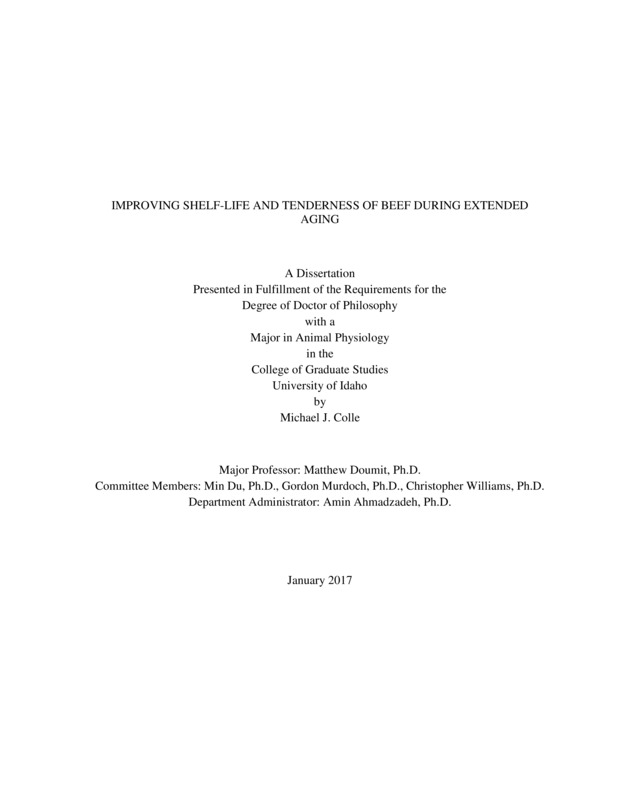Improving Shelf-Life and Tenderness of Beef During Extended Aging
Colle, Michael. (2017). Improving Shelf-Life and Tenderness of Beef During Extended Aging. Theses and Dissertations Collection, University of Idaho Library Digital Collections. https://www.lib.uidaho.edu/digital/etd/items/colle_idaho_0089e_11041.html
- Title:
- Improving Shelf-Life and Tenderness of Beef During Extended Aging
- Author:
- Colle, Michael
- Date:
- 2017
- Embargo Remove Date:
- 2019-01-23
- Keywords:
- Aging Antioxidant Beef Calpain Freezing Tenderness
- Program:
- Animal and Veterinary Science
- Subject Category:
- Animal sciences
- Abstract:
-
Extended aging (>28 days) leads to improved tenderness of the semimembranosus (SM), while longissimus lumborum (LL) tenderness does not improve past 14 days of aging. Unfortunately, extended aging reduces color stability, increases browning, and increases lipid oxidation. The objectives of this dissertation are to 1) determine the effect of 0.05% ascorbic acid and 0.1% rosemary extract on color stability, microbial growth, lipid oxidation, and consumer sensory acceptability of extended aged beef LL and SM, 2) determine the effect of extended aging on calpain-1 and -2 activity in beef LL and SM, and 3) determine the effect of calcium chloride injection or post rigor freezing on sarcoplasmic calcium concentrations and calpain-2 activity in beef LL and SM. Ascorbic acid and rosemary extract treatment increased the lightness but decreased the redness and yellowness of LL steaks. Additionally, treated LL steaks were less brown on day 4 of retail display. The antioxidant treatment did not affect microbial growth, lipid oxidation, or sensory flavor scores. Calpain-1 had minimal activity by day 4 postmortem and was not active following 14 days of aging. Native calpain-2 activity decreased, while autolyzed calpain-2 activity increased with longer aging. Free calcium levels in the calcium, frozen, and control steaks averaged 1256, 127, and 121µM for the LL and 1520, 120, and 111µM for the SM, respectively. LL native calpain-2 activity was lower in calcium and frozen steaks than control steaks, while SM native calpain-2 activity was lowest in calcium steaks and intermediate in frozen steaks. LL calcium steaks were more tender than control steaks. Therefore, ascorbic acid and rosemary extract led to minor improvements in shelf-life of extended aged beef. Both calpain-1 and calpain-2 may be responsible for the postmortem improvement of beef tenderness, with calpain-1 being responsible for the tenderness improvement early postmortem and calpain-2 responsible for the improvement during extended aging. Calcium chloride injection and freezing are effective strategies to activate calpain-2 earlier postmortem even though free calcium concentration never reached >300µM in frozen steaks. In conclusion, manipulating calpain-2 to improve tenderness earlier postmortem is a more feasible strategy to improve product quality than extended aging.
- Description:
- doctoral, Ph.D., Animal and Veterinary Science -- University of Idaho - College of Graduate Studies, 2017
- Major Professor:
- Doumit, Matthew E
- Committee:
- Du, Min; Murdoch, Gordon; Williams, Christopher
- Defense Date:
- 2017
- Identifier:
- Colle_idaho_0089E_11041
- Type:
- Text
- Format Original:
- Format:
- application/pdf
- Rights:
- In Copyright - Educational Use Permitted. For more information, please contact University of Idaho Library Special Collections and Archives Department at libspec@uidaho.edu.
- Standardized Rights:
- http://rightsstatements.org/vocab/InC-EDU/1.0/

